
512Kx36 & 1Mx18 & 2Mx8 DDRII CIO b4 SRAM
- 1 -
Rev 0.4
June. 2003
K7I163684B
K7I161884B
K7I160884B
Preliminary
Document Title
512Kx36-bit, 1Mx18-bit, 2Mx8-bit DDRII CIO b4 SRAM
The attached data sheets are prepared and approved by SAMSUNG Electronics. SAMSUNG Electronics CO., LTD. reserve the right to change the
specifications. SAMSUNG Electronics will evaluate and reply to your requests and questions on the parameters of this device. If you have any ques-
tions, please contact the SAMSUNG branch office near your office, call or contact Headquarters.
Revision History
Rev. No.
0.0
0.1
0.2
0.3
0.4
Remark
Advance
Preliminary
Preliminary
Preliminary
Preliminary
History
1. Initial document.
2. Add the speed bin (-25)
1. Correct the JTAG ID register definition
2. Correct the AC timing parameter (delete the tKHKH Max value)
1. Change the Maximum Clock cycle time.
2. Correct the 165FBGA package ball size.
1. Add the power up/down sequencing comment.
2. Update the DC current parameter (Icc and Isb).
3. Change the Max. speed bin from -33 to -30.
Draft Date
Dec. 16, 2002
Jan. 27, 2003
Mar. 20, 2003
April. 4, 2003
June. 20, 2003
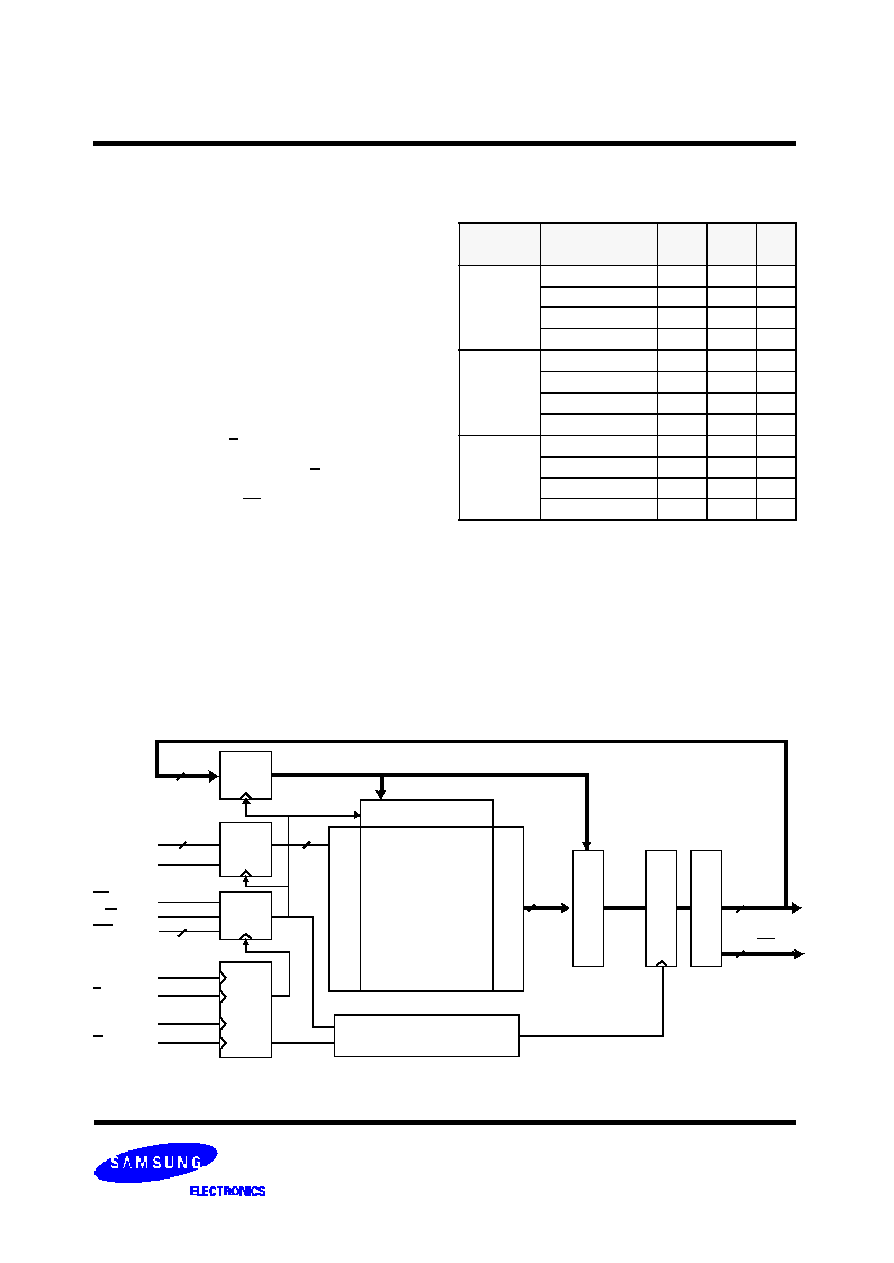
512Kx36 & 1Mx18 & 2Mx8 DDRII CIO b4 SRAM
- 2 -
Rev 0.4
June. 2003
K7I163684B
K7I161884B
K7I160884B
Preliminary
512Kx36-bit, 1Mx18-bit, 2Mx8-bit DDRII CIO b4 SRAM
FEATURES
FUNCTIONAL BLOCK DIAGRAM
∑
1.8V+0.1V/-0.1V Power Supply.
∑
DLL circuitry for wide output data valid window and future
freguency scaling.
∑ I/O Supply Voltage 1.5V+0.1V/-0.1V for 1.5V I/O,
1.8V+0.1V/-0.1V for 1.8V I/O
.
∑
Pipelined, double-data rate operation.
∑ Common data input/output bus .
∑ HSTL I/O
∑ Full data coherency, providing most current data.
∑ Synchronous pipeline read with self timed late write.
∑ Registered address, control and data input/output.
∑ DDR(Double Data Rate) Interface on read and write ports.
∑ Fixed 4-bit burst for both read and write operation.
∑ Clock-stop supports to reduce current.
∑
Two input clocks(K and K) for accurate DDR timing at clock
rising edges only.
∑
Two input clocks for output data(C and C) to minimize
clock-skew and flight-time mismatches.
∑
Two echo clocks (CQ and CQ) to enhance output data
traceability.
∑
Single address bus.
∑
Byte write (x18, x36) and nybble(x8) write function.
∑ Simple depth expansion with no data contention.
∑
Programmable output impedance.
∑ JTAG 1149.1 compatible test access port.
∑ 165FBGA(11x15 ball aray FBGA) with body size of 13x15mm
Organization
Part
Number
Cycle
Time
Access
Time
Unit
X36
K7I163684B-FC30
3.3
0.45
ns
K7I163684B-FC25
4.0
0.45
ns
K7I163684B-FC20
5.0
0.45
ns
K7I163684B-FC16
6.0
0.50
ns
X18
K7I161884B-FC30
3.3
0.45
ns
K7I161884B-FC25
4.0
0.45
ns
K7I161884B-FC20
5.0
0.45
ns
K7I161884B-FC16
6.0
0.50
ns
X8
K7I160884B-FC30
3.3
0.45
ns
K7I160884B-FC25
4.0
0.45
ns
K7I160884B-FC20
5.0
0.45
ns
K7I160884B-FC16
6.0
0.50
ns
LD
ADDRESS
R/W
C
C
ADD REG
&
BURST
LOGIC
DATA
REG
CLK
GEN
CTRL
LOGIC
512kx36
(1Mx18)
MEMORY
ARRAY
WRITE DRIVER
K
K
BW
X
4(or 2)
DQ
SELECT OUTPUT CONTROL
S
E
N
S
E
A
M
P
S
W
R
I
T
E
/
R
E
A
D
D
E
C
O
D
E
O
U
T
P
U
T
R
E
G
O
U
T
P
U
T
S
E
L
E
C
T
O
U
T
P
U
T
D
R
I
V
E
R
Notes
: 1. Numbers in ( ) are for x18 device, x8 device also the same with appropriate adjustments of depth and width.
17
17 (or 18)
36 (or 18)
36 (or 18)
72
72
(Echo Clock out)
CQ, CQ
36 (or 18)
A0,A1
DDRII SRAM and Double Data Rate comprise a new family of products developed by Cypress, Hitachi, IDT, Micron, NEC and Samsung te chnology.
(or 18)
(or 36)
(or 36)

512Kx36 & 1Mx18 & 2Mx8 DDRII CIO b4 SRAM
- 3 -
Rev 0.4
June. 2003
K7I163684B
K7I161884B
K7I160884B
Preliminary
PIN CONFIGURATIONS
(TOP VIEW) K7I163684B(512Kx36)
Notes :
1. * Checked No Connect(NC) pins are reserved for higher density address, i.e. 3A for 36Mb, 10A for 72Mb, 2A for 144Mb .
2. BW
0
controls write to DQ0:DQ8, BW
1
controls write to DQ9:DQ17, BW
2
controls write to DQ18:DQ26 and BW
3
controls write to DQ27:DQ35.
1
2
3
4
5
6
7
8
9
10
11
A
CQ
V
SS/
SA*
NC/SA*
R/W
B W
2
K
BW
1
LD
SA
V
SS/
SA*
CQ
B
NC
DQ27
DQ18
SA
B W
3
K
BW
0
SA
NC
NC
DQ8
C
NC
NC
DQ28
V
SS
SA
SA0
SA1
V
SS
NC
DQ17
DQ7
D
NC
DQ29
DQ19
V
SS
V
SS
V
SS
V
SS
V
SS
NC
NC
DQ16
E
NC
NC
DQ20
V
DDQ
V
SS
V
SS
V
SS
V
DDQ
NC
DQ15
DQ6
F
NC
DQ30
DQ21
V
DDQ
V
DD
V
SS
V
DD
V
DDQ
NC
NC
DQ5
G
NC
DQ31
DQ22
V
DDQ
V
DD
V
SS
V
DD
V
DDQ
NC
NC
DQ14
H
Doff
V
REF
V
DDQ
V
DDQ
V
DD
V
SS
V
DD
V
DDQ
V
DDQ
V
REF
ZQ
J
NC
NC
DQ32
V
DDQ
V
DD
V
SS
V
DD
V
DDQ
NC
DQ13
DQ4
K
NC
NC
DQ23
V
DDQ
V
DD
V
SS
V
DD
V
DDQ
NC
DQ12
DQ3
L
NC
DQ33
DQ24
V
DDQ
V
SS
V
SS
V
SS
V
DDQ
NC
NC
DQ2
M
NC
NC
DQ34
V
SS
V
SS
V
SS
V
SS
V
SS
NC
DQ11
DQ1
N
NC
DQ35
DQ25
V
SS
SA
SA
SA
V
SS
NC
NC
DQ10
P
NC
NC
DQ26
SA
SA
C
SA
SA
NC
DQ9
DQ0
R
TDO
TCK
S A
SA
SA
C
SA
SA
SA
TMS
TDI
PIN NAME
Notes:
1. C, C, K or K cannot be set to V
REF
voltage.
2. When ZQ pin is directly connected to V
DD
output impedance is set to minimum value
and it cannot be connected to ground or left unconnected.
3. Not connected to chip pad internally.
SYMBOL
PIN NUMBERS
DESCRIPTION
NOTE
K, K
6B, 6A
Input Clock
C, C
6P, 6R
Input Clock for Output Data
1
CQ, CQ
11A, 1A
Output Echo Clock
Doff
1H
DLL Disable when low
SA0,SA1
6C,7C
Burst Count Address Inputs
SA
9A,4B,8B,5C,5N-7N,4P,5P,7P,8P,3R-5R,7R-9R
Address Inputs
DQ0-35
2B,3B,11B,3C,10C,11C,2D,3D,11D,3E,10E,11E,2F,3F
11F,2G,3G,11G,3J,10J,11J,3K,10K,11K,2L,3L,11L
3M,10M,11M,2N,3N,11N,3P,10P,11P
Data Inputs Outputs
R/W
4A
Read, Write Control Pin, Read active
when high
LD
8A
Synchronous Load Pin, bus Cycle
sequence is to be defined when low
B W
0
, BW
1,
BW
2
, B W
3
7B,7A,5A,5B
Block Write Control Pin,active when low
V
REF
2H,10H
Input Reference Voltage
ZQ
11H
Output Driver Impedance Control Input
2
V
DD
5F,7F,5G,7G,5H,7H,5J,7J,5K,7K
Power Supply ( 1.8 V )
V
DDQ
4E,8E,4F,8F,4G,8G,3H,4H,8H,9H,4J,8J,4K,8K,4L,8L
Output Power Supply ( 1.5V or 1.8V )
V
SS
2A,10A,4C,8C,4D-8D,5E-7E,6F,6G,6H,6J,6K,5L-7L,
4M-8M,4N,8N
Ground
TMS
10R
JTAG Test Mode Select
TDI
11R
JTAG Test Data Input
TCK
2R
JTAG Test Clock
TDO
1R
JTAG Test Data Output
NC
3A,1B,9B,10B,1C,2C,9C,1D,9D,10D,1E,2E,9E,
1F,9F,10F,1G,9G,10G,1J,2J,9J,1K,2K,9K
1L,9L,10L,1M,2M,9M,1N,9N,10N,1P,2P,9P
No Connect
3

512Kx36 & 1Mx18 & 2Mx8 DDRII CIO b4 SRAM
- 4 -
Rev 0.4
June. 2003
K7I163684B
K7I161884B
K7I160884B
Preliminary
PIN CONFIGURATIONS
(TOP VIEW) K7I161884B(1Mx18)
Notes:
1. * Checked No Connect(NC) pins are reserved for higher density address, i.e. 10A for 36Mb, 2A for 72Mb.
2. BW
0
controls write to DQ0:DQ8 and BW
1
controls write to DQ9:DQ17.
1
2
3
4
5
6
7
8
9
10
11
A
CQ
V
SS/
SA*
SA
R/W
BW
1
K
NC
LD
S A
Vss/SA*
CQ
B
NC
DQ9
NC
SA
NC
K
BW
0
SA
NC
NC
DQ8
C
NC
NC
NC
V
SS
SA
SA0
SA1
V
SS
NC
DQ7
NC
D
NC
NC
DQ10
V
SS
V
SS
V
SS
V
SS
V
SS
NC
NC
NC
E
NC
NC
DQ11
V
DDQ
V
SS
V
SS
V
SS
V
DDQ
NC
NC
DQ6
F
NC
DQ12
NC
V
DDQ
V
DD
V
SS
V
DD
V
DDQ
NC
NC
DQ5
G
NC
NC
DQ13
V
DDQ
V
DD
V
SS
V
DD
V
DDQ
NC
NC
NC
H
Doff
V
REF
V
DDQ
V
DDQ
V
DD
V
SS
V
DD
V
DDQ
V
DDQ
V
REF
ZQ
J
NC
NC
NC
V
DDQ
V
DD
V
SS
V
DD
V
DDQ
NC
DQ4
NC
K
NC
NC
DQ14
V
DDQ
V
DD
V
SS
V
DD
V
DDQ
NC
NC
DQ3
L
NC
DQ15
NC
V
DDQ
V
SS
V
SS
V
SS
V
DDQ
NC
NC
DQ2
M
NC
NC
NC
V
SS
V
SS
V
SS
V
SS
V
SS
NC
DQ1
NC
N
NC
NC
DQ16
V
SS
SA
SA
SA
V
SS
NC
NC
NC
P
NC
NC
DQ17
SA
SA
C
SA
SA
NC
NC
DQ0
R
TDO
TCK
SA
SA
SA
C
SA
SA
S A
TMS
TDI
PIN NAME
Notes:
1. C, C, K or K cannot be set to V
R E F
voltage.
2. When ZQ pin is directly connected to V
DD
output impedance is set to minimum value
and it cannot be connected to ground or left unconnected.
3. Not connected to chip pad internally.
SYMBOL
PIN NUMBERS
DESCRIPTION
NOTE
K, K
6B, 6A
Input Clock
C, C
6P, 6R
Input Clock for Output Data
1
CQ, CQ
11A, 1A
Output Echo Clock
Doff
1H
DLL Disable when low
SA0,SA1
6C,7C
Burst Count Address Inputs
SA
3A,9A,4B,8B,5C,5N-7N,4P,5P,7P,8P,3R-5R,7R-9R
Address Inputs
DQ0-17
2B,11B,10C,3D,3E,11E,2F,11F,3G,10J,3K,11K,2L,11L
10M,3N,3P,11P
Data Inputs Outputs
R/W
4A
Read, Write Control Pin, Read active
when high
LD
8A
Synchronous Load Pin, bus Cycle
sequence is to be defined when low
B W
0
, BW
1
7B, 5A
Block Write Control Pin,active when low
V
REF
2H,10H
Input Reference Voltage
ZQ
11H
Output Driver Impedance Control Input
2
V
DD
5F,7F,5G,7G,5H,7H,5J,7J,5K,7K
Power Supply ( 1.8 V )
V
DDQ
4E,8E,4F,8F,4G,8G,3H,4H,8H,9H,4J,8J,4K,8K,4L,8L
Output Power Supply ( 1.5V or 1.8V )
V
SS
10A,2A,4C,8C,4D-8D,5E-7E,6F,6G,6H,6J,6K,5L-7L,4M-8M,4N,8N
Ground
TMS
10R
JTAG Test Mode Select
TDI
11R
JTAG Test Data Input
TCK
2R
JTAG Test Clock
TDO
1R
JTAG Test Data Output
NC
7A,1B,3B,5B,9B,10B,1C,2C,3C,9C,11C,1D,2D,9D,10D,11D
1E,2E,9E,10E,1F,3F,9F,10F,1G,2G,9G,10G,11G
1J,2J,3J,9J,11J,1K,2K,9K,10K,1L,3L,9L,10L
1M,2M,3M,9M,11M,1N,2N,9N,10N,11N,1P,2P,9P,10P
No Connect
3
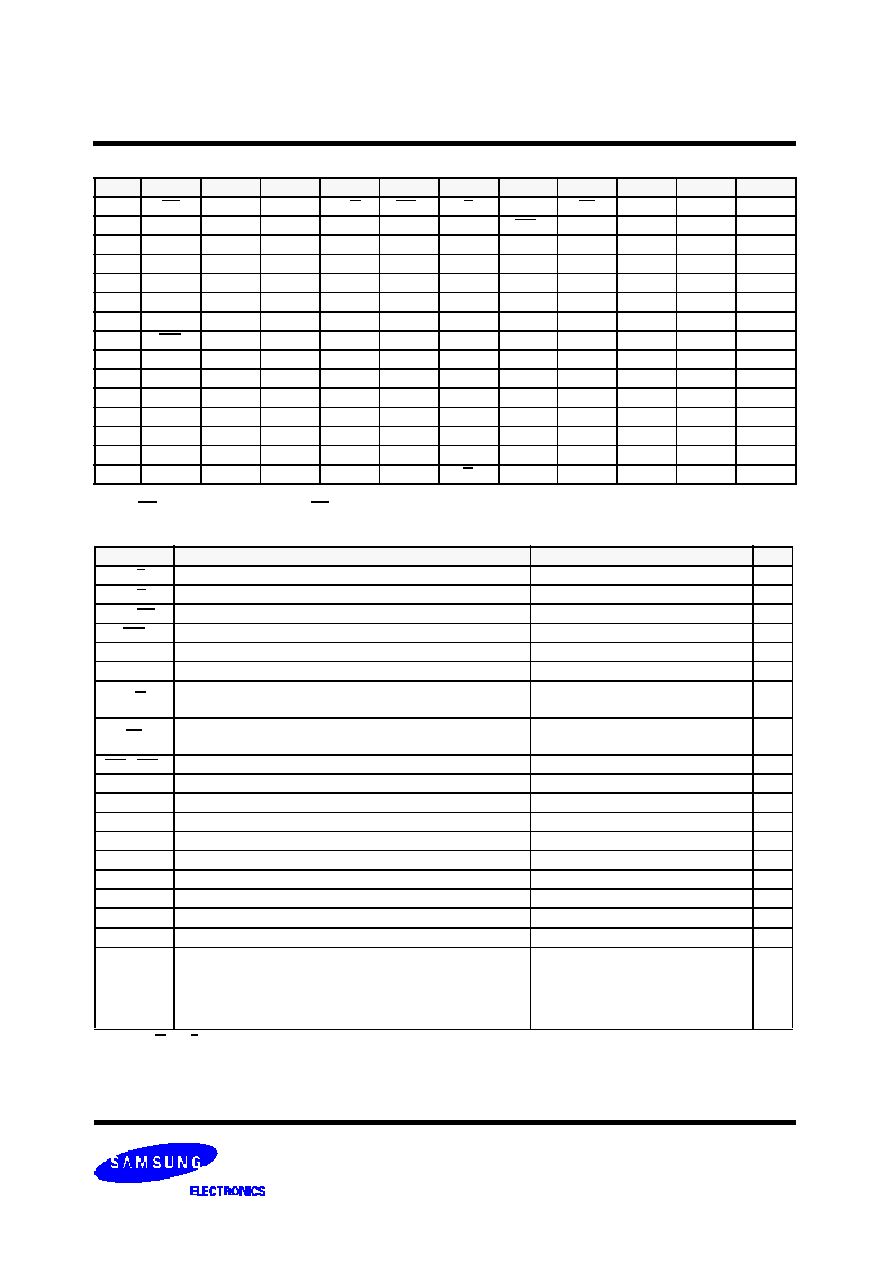
512Kx36 & 1Mx18 & 2Mx8 DDRII CIO b4 SRAM
- 5 -
Rev 0.4
June. 2003
K7I163684B
K7I161884B
K7I160884B
Preliminary
PIN CONFIGURATIONS
(TOP VIEW) K7I160884B(2Mx8)
Notes:
1. * Checked No Connect(NC) pin is reserved for higher density address, i.e. 2A for 72Mb.
2. NW
0
controls write to DQ0:DQ3 and NW
1
controls write to DQ4:DQ7.
1
2
3
4
5
6
7
8
9
10
11
A
CQ
V
SS/
SA*
SA
R/W
NW
1
K
NC
LD
S A
Vss/SA*
CQ
B
NC
NC
NC
SA
NC
K
NW
0
SA
NC
NC
DQ3
C
NC
NC
NC
V
SS
SA
NC
SA
V
SS
NC
NC
NC
D
NC
NC
NC
V
SS
V
SS
V
SS
V
SS
V
SS
NC
NC
NC
E
NC
NC
DQ4
V
DDQ
V
SS
V
SS
V
SS
V
DDQ
NC
NC
DQ2
F
NC
NC
NC
V
DDQ
V
DD
V
SS
V
DD
V
DDQ
NC
NC
NC
G
NC
NC
DQ5
V
DDQ
V
DD
V
SS
V
DD
V
DDQ
NC
NC
NC
H
Doff
V
REF
V
DDQ
V
DDQ
V
DD
V
SS
V
DD
V
DDQ
V
DDQ
V
REF
ZQ
J
NC
NC
NC
V
DDQ
V
DD
V
SS
V
DD
V
DDQ
NC
DQ1
NC
K
NC
NC
NC
V
DDQ
V
DD
V
SS
V
DD
V
DDQ
NC
NC
NC
L
NC
DQ6
NC
V
DDQ
V
SS
V
SS
V
SS
V
DDQ
NC
NC
DQ0
M
NC
NC
NC
V
SS
V
SS
V
SS
V
SS
V
SS
NC
NC
NC
N
NC
NC
NC
V
SS
SA
SA
SA
V
SS
NC
NC
NC
P
NC
NC
DQ7
SA
SA
C
SA
SA
NC
NC
NC
R
TDO
TCK
SA
SA
SA
C
SA
SA
S A
TMS
TDI
PIN NAME
Notes:
1. C, C, K or K cannot be set to V
R E F
voltage.
2. When ZQ pin is directly connected to V
DD
output impedance is set to minimum value
and it cannot be connected to ground or left unconnected.
3. Not connected to chip pad internally.
4. The X8 product does not permit random start address on the least significant address bit.
SYMBOL
PIN NUMBERS
DESCRIPTION
NOTE
K, K
6B, 6A
Input Clock
C, C
6P, 6R
Input Clock for Output Data
1
CQ, CQ
11A, 1A
Output Echo Clock
Doff
1H
DLL Disable when low
SA
3A,9A,4B,8B,5C,7C,5N-7N,4P,5P,7P,8P,3R-5R,7R-9R
Address Inputs
DQ0-7
10J,11B,3E,11E,3G,2L,11L,3P
Data Inputs Outputs
R/W
4A
Read, Write Control Pin, Read active
when high
LD
8A
Synchronous Load Pin, bus Cycle
sequence is to be defined when low
NW
0
, NW
1
7B, 5A
Nybble Write Control Pin,active when low
V
REF
2H,10H
Input Reference Voltage
ZQ
11H
Output Driver Impedance Control Input
2
V
DD
5F,7F,5G,7G,5H,7H,5J,7J,5K,7K
Power Supply ( 1.8 V )
V
DDQ
4E,8E,4F,8F,4G,8G,3H,4H,8H,9H,4J,8J,4K,8K,4L,8L
Output Power Supply ( 1.5V or 1.8V )
V
SS
2A,10A,4C,8C,4D-8D,5E-7E,6F,6G,6H,6J,6K,5L-7L,4M-8M,4N,8N
Ground
TMS
10R
JTAG Test Mode Select
TDI
11R
JTAG Test Data Input
TCK
2R
JTAG Test Clock
TDO
1R
JTAG Test Data Output
NC
7A,1B,2B,3B,5B,9B,10B,1C,2C,3C,7C,9C,10C,11C
1D,2D,3D,9D,10D,11D,1E,2E,9E,10E,1F,2F,3F,9F,10F,11F
1G,2G,9G,10G,11G,1J,2J,3J,9J,11J,1K,2K,3K,9K,10K,11K
1L,3L,9L,10L,1M,2M,3M,9M,10M,11M,1N,2N,3N,9N,10N
11N,1P,2P,9P,10P,11P
No Connect
3

512Kx36 & 1Mx18 & 2Mx8 DDRII CIO b4 SRAM
- 6 -
Rev 0.4
June. 2003
K7I163684B
K7I161884B
K7I160884B
Preliminary
The K7I163684B,K7I161884B and K7I160884B are 18,874,368-bits DDR Common I/O
Synchronous Pipelined Burst SRAMs.
They are organized as 524,288 words by 36bits for K7I163684B, 1,048,576 words by 18 bits for K7I161884B and
2,097,152 words by 8bits for K7I160884B.
Address, data inputs, and all control signals are synchronized to the input clock ( K or K ).
Normally data outputs are synchronized to output clocks ( C and C ), but when C and C are tied high,
the data outputs are synchronized to the input clocks ( K and K ).
Read data are referenced to echo clock ( CQ or CQ ) outputs.
Read address and write address are registered on rising edges of the input K clocks.
Common address bus is used to access address both for read and write operations.
The internal burst counter is fiexd to 4-bit sequential for both read and write operations.
Synchronous pipeline read and late write enable high speed operations.
Simple depth expansion is accomplished by using LD for port selection.
Byte write operation is supported with BW
0
and BW
1
( BW
2
and B W
3)
pins for x18 ( x36 ) device.
Nybble write operation is supported with NW
0
and NW
1
pins for x8 device.
IEEE 1149.1 serial boundary scan (JTAG) simplifies monitoriing package pads attachment status with system.
The K7I163684B,K7I161884B and K7I160884B are implemented with SAMSUNG's high performance 6T CMOS technology
and is available in 165pin FBGA packages. Multiple power and ground pins minimize ground bounce.
GENERAL DESCRIPTION
Read Operations
Read cycles are initiated by initiating R/W as high at the rising edge of the positive input clock K.
Address is presented and stored in the read address register synchronized with K clock.
For 4-bit burst DDR operation, it will access four 36-bit, 18-bit or 8-bit data words with each read command.
The first pipelined data is transfered out of the device triggered by C clock following next K clock rising edge.
Next burst data is triggered by the rising edge of following C clock rising edge.
Continuous read operations are initated with K clock rising edge.
And pipelined data are transferred out of device on every rising edge of both C and C clocks.
In case C and C tied to high, output data are triggered by K and K insted of C and C.
When the LD is disabled after a read operation, the K7I163684B,K7I161884B and K7I160884B will first complete
burst read operation before entering into deselect mode at the next K clock rising edge.
Then output drivers disabled automatically to high impedance state.
Echo clock operation
To assure the output tracibility, the SRAM provides the output Echo clock, pair of compliment clock CQ and CQ,
which are synchronized with internal data output.
Echo clocks run free during normal operation.
The Echo clock is triggered by internal output clock signal, and transfered to external through same structures
as output driver.
The following power-up supply voltage application is recommended: V
SS
, V
DD
, V
DDQ
, V
REF
, then V
IN
. V
DD
and V
DDQ
can be applied
simultaneously, as long as V
DDQ
does not exceed V
DD
by more than 0.5V during power-up. The following power-down supply voltage
removal sequence is recommended: V
IN
, V
REF
, V
DDQ
, V
DD
, V
SS
. V
DD
and V
DDQ
can be removed simultaneously, as long as V
DDQ
does not exceed V
DD
by more than 0.5V during power-down.
Power-Up/Power-Down Supply Voltage Sequencing
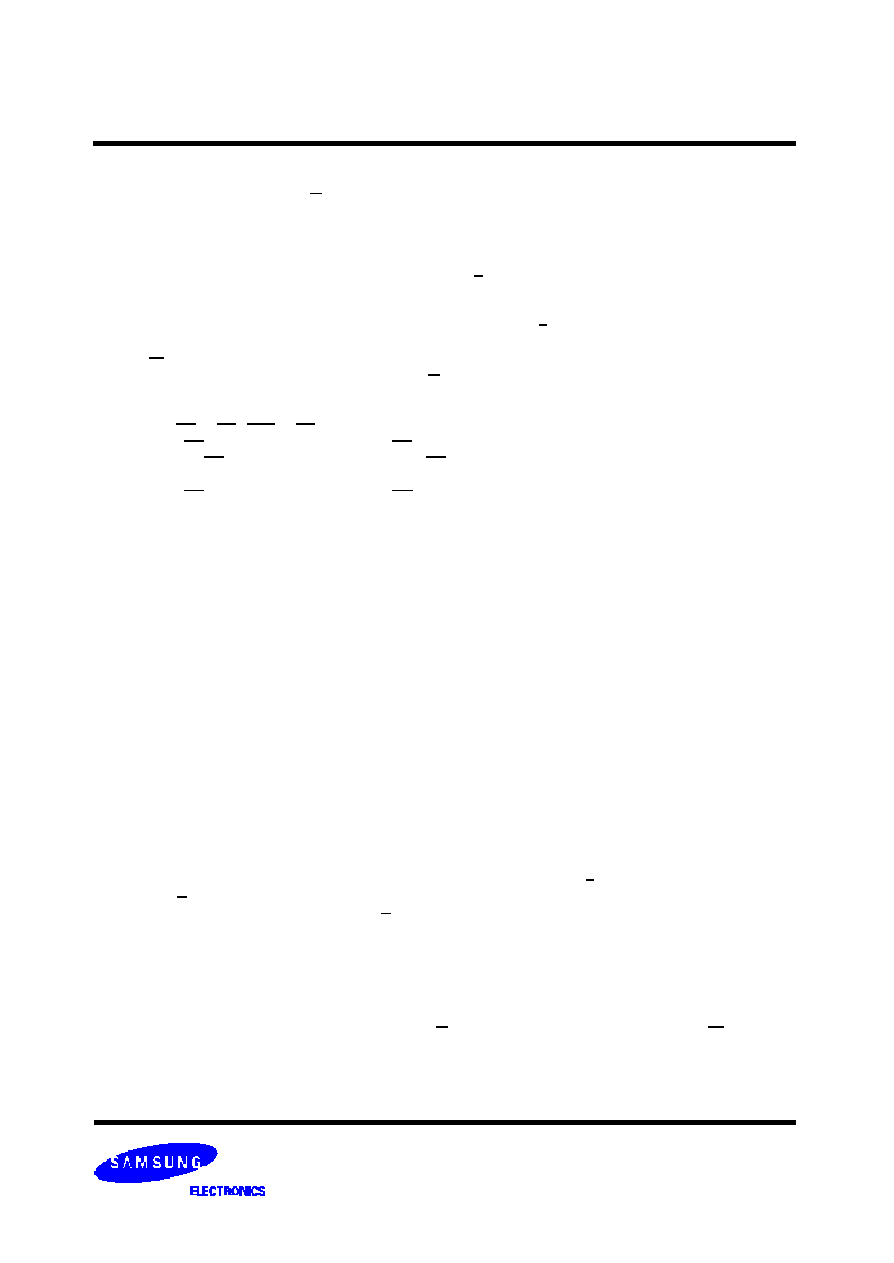
512Kx36 & 1Mx18 & 2Mx8 DDRII CIO b4 SRAM
- 7 -
Rev 0.4
June. 2003
K7I163684B
K7I161884B
K7I160884B
Preliminary
Write cycles are initiated by activating R/ W as low at the rising edge of the positive input clock K.
Address is presented and stored in the write address register synchronized with next K clock.
For 4-bit burst DDR operation, it will write two 36-bit, 18-bit or 8-bit data words with each write command.
The first "late writed" data is transfered and registered in to the device synchronous with next K clock rising edge.
Next burst data is transfered and registered synchronous with following K clock rising edge.
Continuous write operations are initated with K rising edge.
And "late writed" data is presented to the device on every rising edge of both K and K clocks.
When the LD is disabled, the K7I163684B,K7I161884B and K7I160884B will enter into deselect mode.
The device disregards input data presented on the same cycle W disabled.
The K7I163684B and K7I161884B support byte write operations.
With activating BW
0
or BW
1
( BW
2
or BW
3 )
in write cycle, only one byte of input data is presented.
In K7I161884B B W
0
controls write operation to D0:D8, B W
1
controls write operation to D9:D17.
And in K7I163684B BW
2
controls write operation to D18:D26, BW
3
controls write operation to D27:D35.
The the K7I160884B support nybble write operations.
In K7I160884B, NW
0
controls write operation to D0:D3, NW
1
controls write operation to D4:D7.
Write Operations
Programmable Impedance Output Buffer Operation
Single Clock Mode
Depth Expansion
The designer can program the SRAM's output buffer impedance by terminating the ZQ pin to V
SS
through a precision resistor(RQ).
The value of RQ (within 15%) is five times the output impedance desired.
For example, 250
resistor will give an output impedance of 50
.
Impedance updates occur early in cycles that do not activate the outputs, such as deselect cycles.
In all cases impedance updates are transparent to the user and do not produce access time "push-outs" or other anomalous behav-
ior in the SRAM.
There are no power up requirements for the SRAM. However, to guarantee optimum output driver impedance after power up, the
SRAM needs 1024 non-read cycles.
K7I163684B, K7I161884B and K7I160884B can be operated with the single clock pair K and K,
insted of C or C for output clocks.
To operate these devices in single clock mode, C and C must be tied high during power up and must be maintained high
during operation.
After power up, this device can
t change to or from single clock mode.
System flight time and clock skew could not be compensated in this mode.
Each port can be selected and deselected independently with R/W be shared among all SRAMs and provide a new LD signal
for each bank.
Before chip deselected, all read and write pending operations are completed.
Clock Consideration
K7I163684B, K7I161884B and K7I160884B utilize internal DLL(Delay-Locked Loops) for maximum output data valid window.
It can be placed into a stopped-clock state to minimize power with a modest restart time of 1024 clock cycles.
Circuitry automatically resets the DLL when absence of input clock is detected.
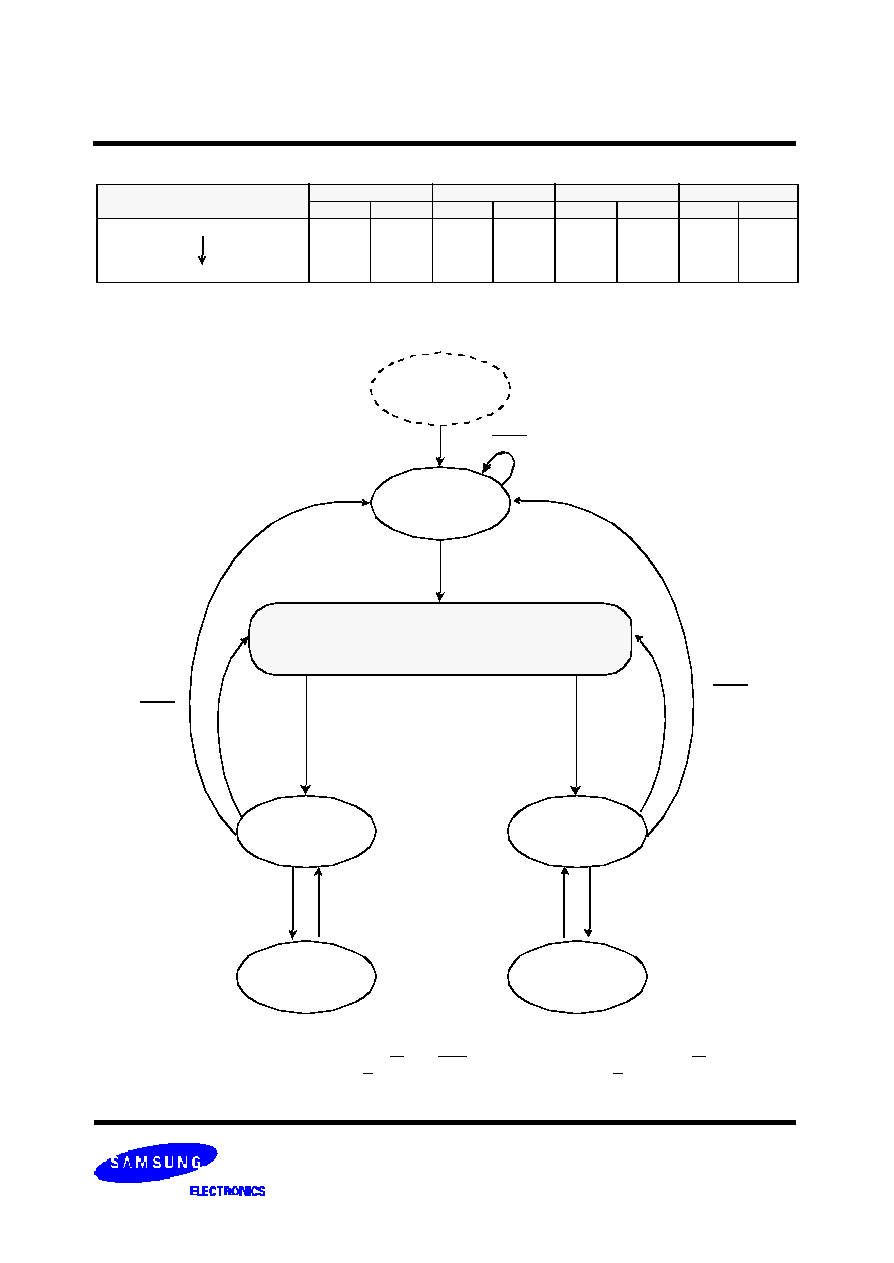
512Kx36 & 1Mx18 & 2Mx8 DDRII CIO b4 SRAM
- 8 -
Rev 0.4
June. 2003
K7I163684B
K7I161884B
K7I160884B
Preliminary
STATE DIAGRAM
Notes
: 1. Internal burst counter is fixed as 4-bit linear, i.e. when first address is A0+0, next internal burst address is A0+1.
2. "LOAD" refers to read new address active status with LD=Low, "LOAD" refers to read new address inactive status with LD=High.
3. "READ" refers to read active read status with R/W=High, "WRITE" refers to write active status with R/W=Low
LOAD
LOAD
LOAD
LOAD
POWER-UP
NOP
LOAD NEW ADDRESS
LOAD
READ
WRITE
Dcount = 0
Dcount = 2
Dcount = 2
LOAD
READ
Dcount = 1
ALWAYS
WRITE
Dcount = 1
ALWAYS
INCREMENT
READ ADDRESS
INCREMENT
WRITE ADDRESS
DDR READ
Dcount=Dcount+1
DDR WRITE
Dcount=Dcount+1
LINEAR BURST SEQUENCE TABLE
BURST SEQUENCE
Case 1
Case 2
Case 3
Case 4
SA
1
SA
0
SA
1
SA
0
SA
1
SA
0
SA
1
SA
0
First Address
Fourth Address
0
0
1
1
0
1
0
1
0
1
1
0
1
0
1
0
1
1
0
0
0
1
0
1
1
0
0
1
1
0
1
0
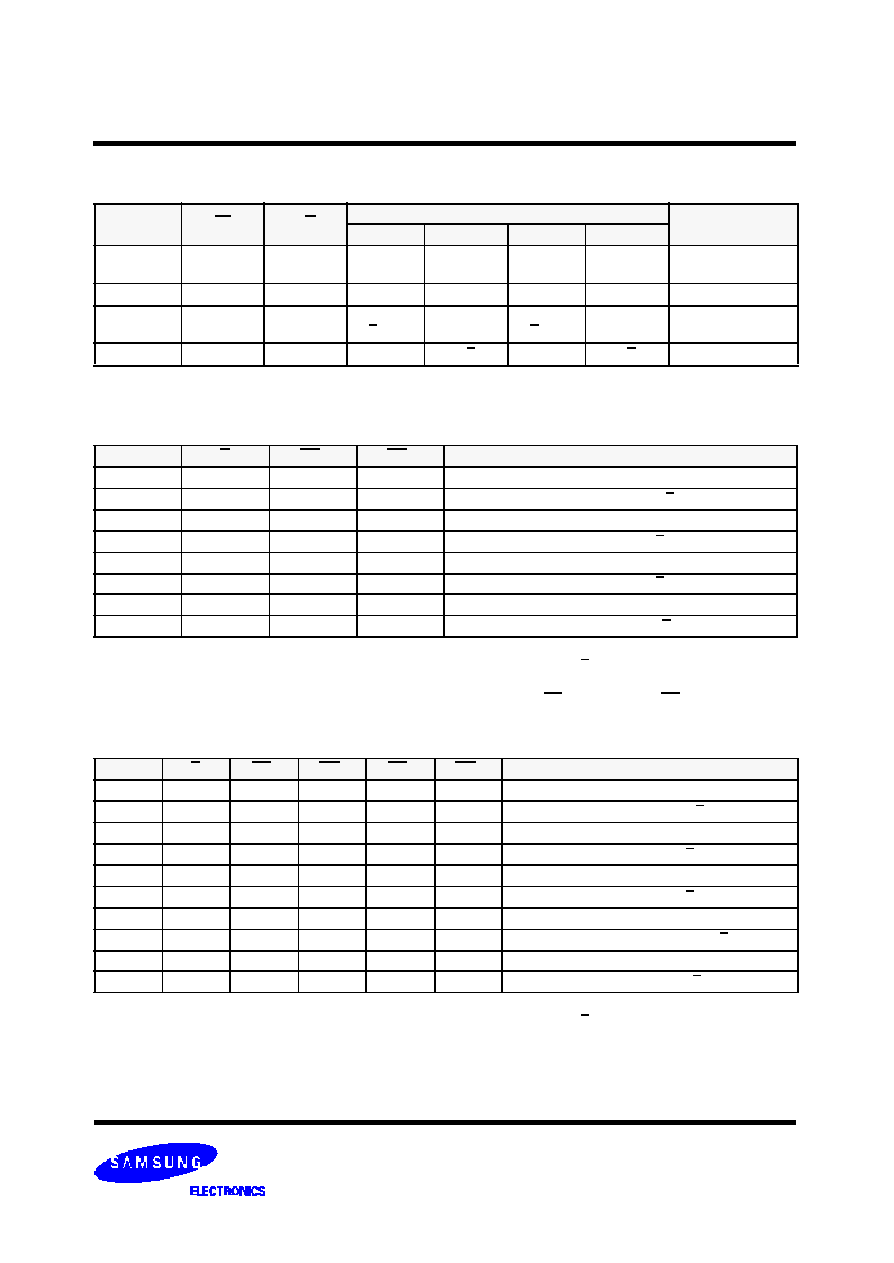
512Kx36 & 1Mx18 & 2Mx8 DDRII CIO b4 SRAM
- 9 -
Rev 0.4
June. 2003
K7I163684B
K7I161884B
K7I160884B
Preliminary
WRITE TRUTH TABLE
(x18)
Notes:
1. X means "Don
t Care".
2. All inputs in this table must meet setup and hold time around the rising edge of input clock K or K (
).
3. Assumes a WRITE cycle was initiated.
4. This table illustates operation for x18 devices. x8 device operation is similar except that NW
0
controls D0:D3 and NW
0
controls D4:D7.
K
K
BW
0
BW
1
OPERATION
L
L
WRITE ALL BYTEs ( K
)
L
L
WRITE ALL BYTEs ( K
)
L
H
WRITE BYTE 0 ( K
)
L
H
WRITE BYTE 0 ( K
)
H
L
WRITE BYTE 1 ( K
)
H
L
WRITE BYTE 1 ( K
)
H
H
WRITE NOTHING ( K
)
H
H
WRITE NOTHING ( K
)
WRITE TRUTH TABLE
(x36)
Notes:
1. X means "Don
t Care".
2. All inputs in this table must meet setup and hold time around the rising edge of input clock K or K (
).
3. Assumes a WRITE cycle was initiated.
K
K
BW
0
BW
1
BW
2
BW
3
OPERATION
L
L
L
L
WRITE ALL BYTEs ( K
)
L
L
L
L
WRITE ALL BYTEs ( K
)
L
H
H
H
WRITE BYTE 0 ( K
)
L
H
H
H
WRITE BYTE 0 ( K
)
H
L
H
H
WRITE BYTE 1 ( K
)
H
L
H
H
WRITE BYTE 1 ( K
)
H
H
L
L
WRITE BYTE 2 and BYTE 3 ( K
)
H
H
L
L
WRITE BYTE 2 and BYTE 3 ( K
)
H
H
H
H
WRITE NOTHING ( K
)
H
H
H
H
WRITE NOTHING ( K
)
TRUTH TABLES
SYNCHRONOUS TRUTH TABLE
Notes:
1. X means "Don
t Care".
2. The rising edge of clock is symbolized by (
).
K
LD
R/W
Q
OPERATION
Q(A0)
Q(A1)
Q(A2)
Q(A3)
Stopped
X
X
Previous
state
Previous
state
Previous
state
Previous
state
Clock Stop
H
X
High-Z
High-Z
High-Z
High-Z
No Operation
L
H
Q
OUT
at
C(t+1)
Q
OUT
at
C(t+2)
Q
OUT
at
C(t+2)
Q
OUT
at
C(t+3)
Read
L
L
Din at K(t+1) Din at K(t+1) Din at K(t+2) Din at K(t+2)
Write

512Kx36 & 1Mx18 & 2Mx8 DDRII CIO b4 SRAM
- 10 -
Rev 0.4
June. 2003
K7I163684B
K7I161884B
K7I160884B
Preliminary
ABSOLUTE MAXIMUM RATINGS*
*Note:
1. Stresses greater than those listed under "Absolute Maximum Ratings" may cause permanent damage to the device. This is a stress rating
only and functional operation of the device at these or any other conditions above those indicated in the operating sections of this specification
is not implied. Exposure to absolute maximum rating conditions for extended periods may affect reliability.
2. V
DDQ
must not exceed V
DD
during normal operation.
PARAMETER
SYMBOL
RATING
UNIT
Voltage on V
DD
Supply Relative to V
SS
V
DD
-0.5 to 2.9
V
Voltage on V
DDQ
Supply Relative to V
SS
V
DDQ
-0.5 to V
DD
V
Voltage on Input Pin Relative to V
SS
V
IN
-0.5 to V
DD+
0.3
V
Storage Temperature
T
STG
-65 to 150
∞
C
Operating Temperature
T
OPR
0 to 70
∞
C
Storage Temperature Range Under Bias
T
BIAS
-10 to 85
∞
C
DC ELECTRICAL CHARACTERISTICS
(V
DD
=1.8V
±
0.1V, T
A
=0
∞
C to +70
∞
C)
Notes:
1. Minimum cycle. I
OUT
=0mA.
2. |I
O H
|=(V
DDQ
/2)/(RQ/5)
±
15% for 175
RQ
350
.
3. |I
O L
|=(V
DDQ
/2)/(RQ/5)
±
15% for 175
RQ
350
.
4. Minimum Impedance Mode when ZQ pin is connected to V
DDQ
.
5. Operating current is calculated with 50% read cycles and 50% write cycles.
6. Standby Current is only after all pending read and write burst opeactions are completed.
7. Programmable Impedance Mode.
8. These are DC test criteria. DC design criteria is V
REF
±
50mV. The AC V
IH
/V
IL
levels are defined separately for measuring
timing parameters.
9. V
IL
(Min)DC=
-
0.3V, V
IL
(Min)AC=-1.5V(pulse width
3ns).
10. V
IH
(Max)DC=
V
DDQ
+0.3, V
IH
(Max)AC=
V
DDQ
+0.85V(pulse width
3ns).
PARAMETER
SYMBOL
TEST CONDITIONS
MIN
MAX
UNIT NOTE
Input Leakage Current
I
IL
V
DD
=Max ; V
IN
=V
SS
to V
DDQ
-2
+2
µ
A
Output Leakage Current
I
OL
Output Disabled,
-2
+2
µ
A
Operating Current
(x36) : DDR
I
CC
V
DD
=Max , I
OUT
=0mA
Cycle Time
t
KHKH
Min
-30
-
550
mA
1,5
-25
-
500
-20
-
450
-16
400
Operating Current
(x18) : DDR
I
CC
V
DD
=Max , I
OUT
=0mA
Cycle Time
t
KHKH
Min
-30
-
450
mA
1,5
-25
-
400
-20
-
350
-16
300
Operating Current
(x8) : DDR
I
CC
V
DD
=Max , I
OUT
=0mA
Cycle Time
t
KHKH
Min
-30
-
430
mA
1,5
-25
-
380
-20
-
330
-16
280
Standby Current(NOP): DDR
I
SB1
Device deselected,
I
OUT
=0mA, f=Max,
All Inputs
0.2V or
V
DD
-0.2V
-30
-
200
mA
1,6
-25
-
180
-20
-
160
-16
-
140
Output High Voltage
V
OH1
V
DDQ
/2-0.12
V
DDQ
/2+0.12
V
2,7
Output Low Voltage
V
OL1
V
DDQ
/2-0.12
V
DDQ
/2+0.12
V
3,7
Output High Voltage
V
OH2
I
OH
=-1.0mA
V
DDQ
-0.2
V
DDQ
V
4
Output Low Voltage
V
OL2
I
OL
=1.0mA
V
SS
0.2
V
4
Input Low Voltage
V
IL
-0.3
V
REF
-0.1
V
8,9
Input High Voltage
V
IH
V
REF
+0.1
V
DDQ
+0.3
V
8,10
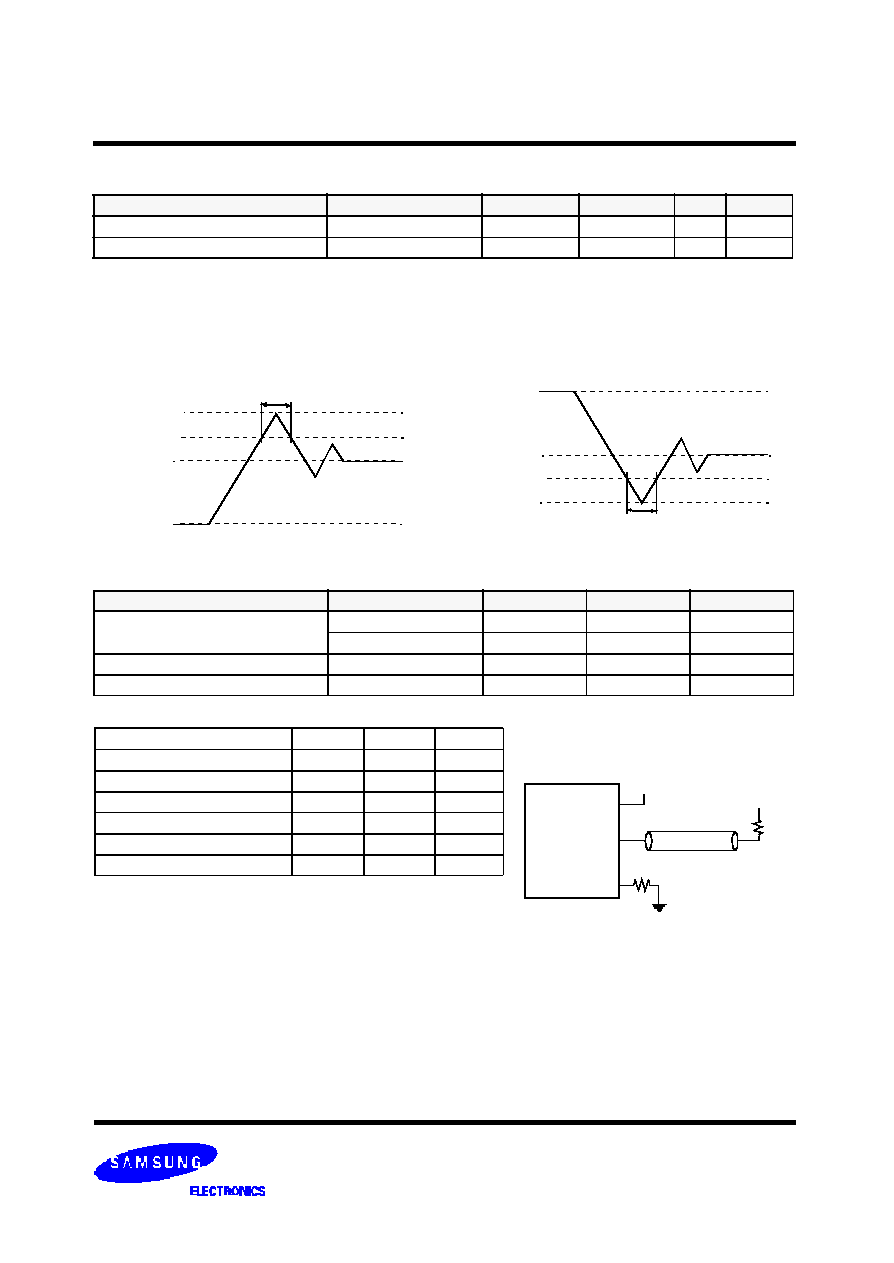
512Kx36 & 1Mx18 & 2Mx8 DDRII CIO b4 SRAM
- 11 -
Rev 0.4
June. 2003
K7I163684B
K7I161884B
K7I160884B
Preliminary
Note:
For power-up, V
IH
V
DDQ
+0.3V and V
DD
1.7V and V
DDQ
1.4V t
200ms
V
DDQ
V
IL
V
DDQ
+0.5V
20% t
KHKH
(MIN)
V
SS
V
IH
V
SS
-0.5V
20% t
KHKH
(MIN)
Undershoot Timing
Overershoot Timing
OPERATING CONDITIONS
(0
∞
C
T
A
70
∞
C)
PARAMETER
SYMBOL
MIN
MAX
UNIT
Supply Voltage
V
DD
1.7
1.9
V
V
DDQ
1.4
1.9
V
Reference
Voltage
V
REF
0.68
0.95
V
Ground
V
SS
0
0
V
V
DDQ
/2
50
SRAM
Zo=50
0.75V
V
REF
ZQ
250
AC TEST OUTPUT LOAD
AC TEST CONDITIONS
Note
: Parameters are tested with RQ=250
Parameter
Symbol
Value
Unit
Core Power Supply Voltage
V
DD
1.7~1.9
V
Output Power Supply Voltage
V
DDQ
1.4~1.9
V
Input High/Low Level
V
IH
/V
IL
1.25/0.25
V
Input Reference Level
V
REF
0.75
V
Input Rise/Fall Time
T
R
/T
F
0.3/0.3
ns
Output Timing Reference Level
V
DDQ
/2
V
AC ELECTRICAL CHARACTERISTICS
(V
DD
=1.8V
±
0.1V, T
A
=0
∞
C to +70
∞
C)
Notes:
1. This condition is for AC function test only, not for AC parameter test.
2. To maintain a valid level, the transitioning edge of the input must :
a) Sustain a constant slew rate from the current AC level through the target AC level, V
IL(AC)
or V
IH(AC)
b) Reach at least the target AC level
c) After the AC target level is reached, continue to maintain at least the target DC level, V
IL(DC)
or V
IH(DC)
PARAMETER
SYMBOL
MIN
MAX
UNIT
NOTES
Input High Voltage
V
IH
(AC)
V
REF
+ 0.2
-
V
1,2
Input Low Voltage
V
IL
(AC)
-
V
REF
- 0.2
V
1,2
V
DDQ
+0.25V
V
SS
-0.25V
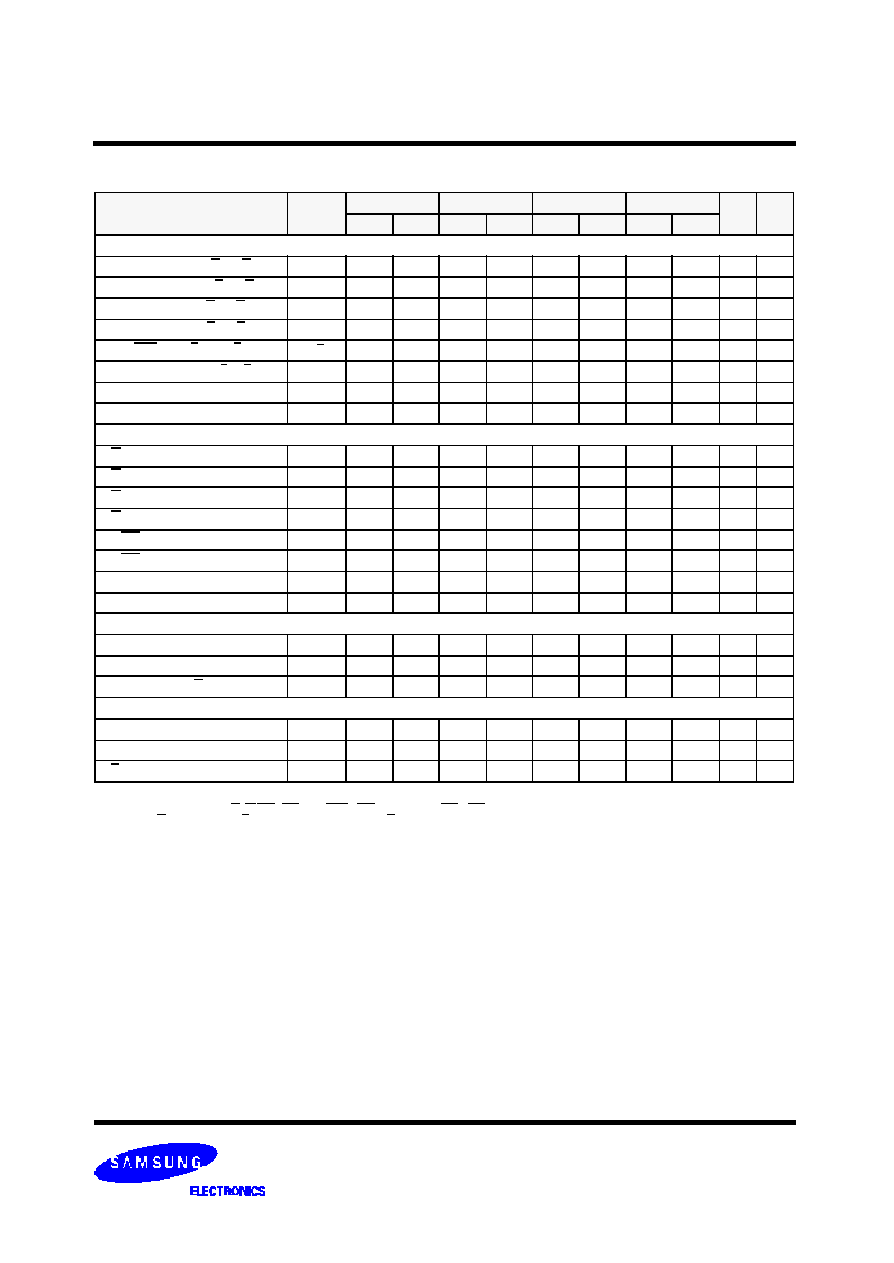
512Kx36 & 1Mx18 & 2Mx8 DDRII CIO b4 SRAM
- 12 -
Rev 0.4
June. 2003
K7I163684B
K7I161884B
K7I160884B
Preliminary
AC TIMING CHARACTERISTICS
(V
DD
=1.8V
±
0.1V, T
A
=0
∞
C to +70
∞
C)
Notes
: 1. All address inputs must meet the specified setup and hold times for all latching clock edges.
2. Control singles are R, W,BW
0
,BW
1
and (NW
0
, NW
1
, for x8) and (BW
2
, BW
3
, also for x36)
3. If C,C are tied high, K,K become the references for C,C timing parameters.
4. To avoid bus contention, at a given voltage and temperature tCHQX
1
is bigger than tCHQZ.
The specs as shown do not imply bus contention beacuse tCHQX
1
is a MIN parameter that is worst case at totally different test conditions
(0
∞
C, 1.9V) than tCHQZ, which is a MAX parameter(worst case at 70
∞
C, 1.7V)
It is not possible for two SRAMs on the same board to be at such different voltage and temperature.
5. Clock phase jitter is the variance from clock rising edge to the next expected clock rising edge.
6. Vdd slew rate must be less than 0.1V DC per 50 ns for DLL lock retention. DLL lock time begins once Vdd and input clock are stable.
7. Echo clock is very tightly controlled to data valid/data hold. By design, there is a
± 0.1
ns variation from echo clock to data.
The data sheet parameters reflect tester guardbands and test setup variations.
PARAMETER
SYMBOL
-30
-25
-20
-16
UNIT NOTE
MIN
MAX
MIN
MAX
MIN
MAX
MIN
MAX
Clock
Clock Cycle Time (K, K, C, C)
t
KHKH
3.30
5.25
4.00
6.30
5.00
7.88
6.00
8.40
ns
Clock Phase Jitter (K, K, C, C)
t
KC var
0.20
0.20
0.20
0.20
ns
5
Clock High Time (K, K , C, C)
t
KHKL
1.32
1.60
2.00
2.40
ns
Clock Low Time (K, K, C, C)
t
KLKH
1.32
1.60
2.00
2.40
ns
Clock to Clock (K
K
, C
C
)
t
KHKH
1.49
1.80
2.20
2.70
ns
Clock to data clock (K
C
, K
C
)
t
KHCH
0.00
1.45
0.00
1.80
0.00
2.30
0.00
2.80
ns
DLL Lock Time (K, C)
t
KC lock
1024
1024
1024
1024
cycle
6
K Static to DLL reset
t
KC reset
30
30
30
30
ns
Output Times
C, C High to Output Valid
t
CHQV
0.45
0.45
0.45
0.50
ns
3
C, C High to Output Hold
t
CHQX
-0.45
-0.45
-0.45
-0.50
ns
3
C, C High to Echo Clock Valid
t
CHCQV
0.45
0.45
0.45
0.50
ns
C, C High to Echo Clock Hold
t
CHCQX
-0.45
-0.45
-0.45
-0.50
ns
CQ, CQ High to Output Valid
t
CQHQV
0.27
0.30
0.35
0.40
ns
7
CQ, CQ High to Output Hold
t
CQHQX
-0.27
-0.30
-0.35
-0.40
ns
7
C, High to Output High-Z
t
CHQZ
0.45
0.45
0.45
0.50
ns
3
C, High to Output Low-Z
t
CHQX1
-0.45
-0.45
-0.45
-0.50
ns
3
Setup Times
Address valid to K rising edge
t
AVKH
0.40
0.50
0.60
0.70
ns
Control inputs valid to K rising edge
t
IVKH
0.40
0.50
0.60
0.70
ns
2
Data-in valid to K, K rising edge
t
DVKH
0.30
0.35
0.40
0.50
ns
Hold Times
K rising edge to address hold
t
KHAX
0.40
0.50
0.60
0.70
ns
K rising edge to control inputs hold
t
KHIX
0.40
0.50
0.60
0.70
ns
K, K rising edge to data-in hold
t
KHDX
0.30
0.35
0.40
0.50
ns
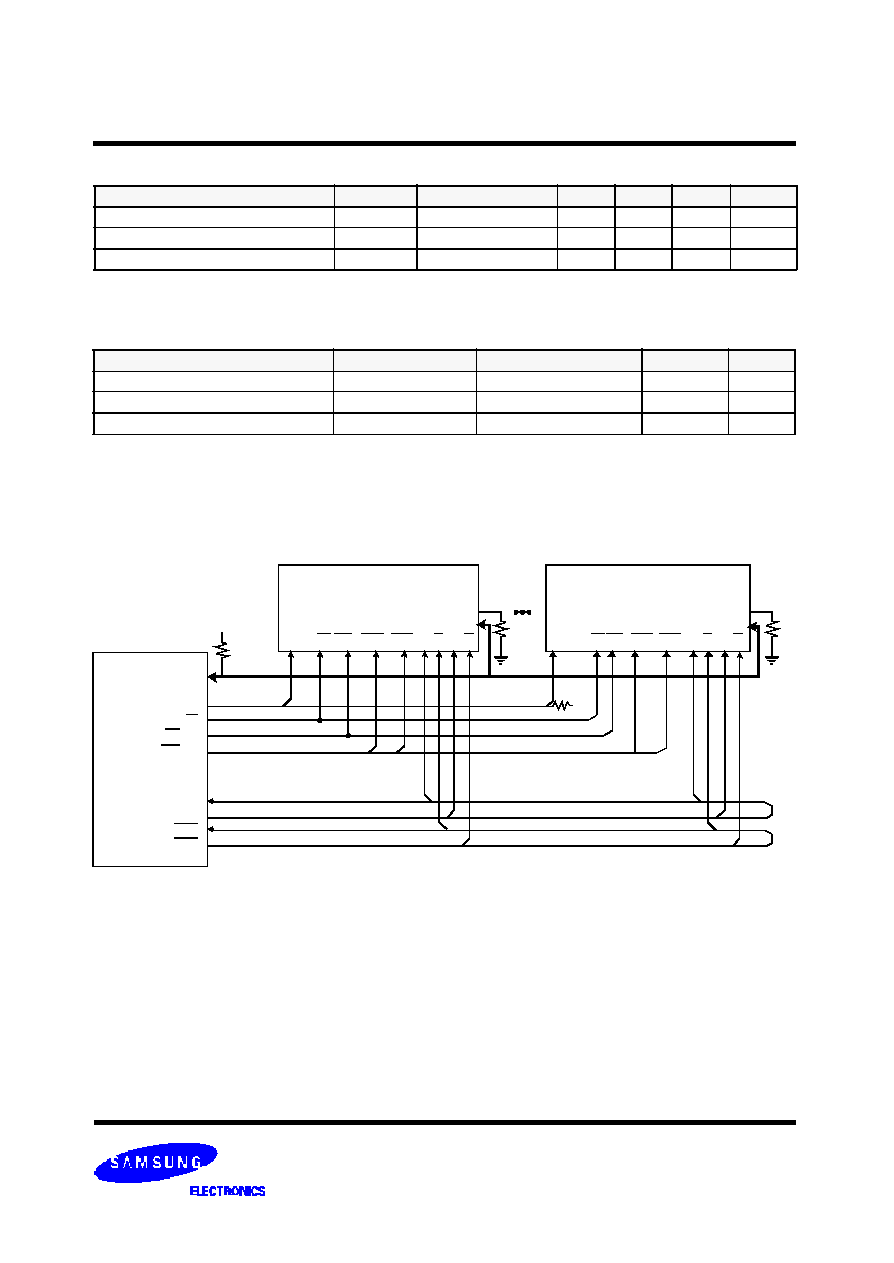
512Kx36 & 1Mx18 & 2Mx8 DDRII CIO b4 SRAM
- 13 -
Rev 0.4
June. 2003
K7I163684B
K7I161884B
K7I160884B
Preliminary
APPLICATION INRORMATION
THERMAL RESISTANCE
Note
: Junction temperature is a function of on-chip power dissipation, package thermal impedance, mounting site temperature and mounting site
thermal impedance. T
J
=T
A
+ P
D
x
JA
PRMETER
SYMBOL
TYP
Unit
NOTES
Junction to Ambient
JA
TBD
∞
C
/W
Junction to Case
JC
TBD
∞
C
/W
Junction to Pins
JB
TBD
∞
C
/W
PIN CAPACITANCE
Note
: 1. Parameters are tested with RQ=250
and V
DDQ
=1.5V.
2. Periodically sampled and not 100% tested.
PRMETER
SYMBOL
TESTCONDITION
Typ
MAX
Unit
NOTES
Address Control Input Capacitance
C
IN
V
IN
=0V
4
5
pF
Input and Output Capacitance
C
OUT
V
OUT
=0V
6
7
pF
Clock Capacitance
C
CLK
-
5
6
pF
1Mx18
SRAM#1
SA R/W
BW
0
DQ
0-17
ZQ
K
C C
SRAM#4
R
Vt
R=50
Vt=V
REF
Vt
R
R=250
R=250
BW
1
K
SA R/WLD3BW
0
DQ
0-17
ZQ
K
C C
BW
1
K
DQ
Address
R/W
LD0-3
BW0-7
Return CLK
Source CLK
Return CLK
Source CLK
MEMORY
CONTROLLER
LD0

512Kx36 & 1Mx18 & 2Mx8 DDRII CIO b4 SRAM
- 14 -
Rev 0.4
June. 2003
K7I163684B
K7I161884B
K7I160884B
Preliminary
NOP
K
K
SA
t
AVKH
t
KHAX
CQ
1
2
3
4
5
6
7
8
10
12
11
LD
CQ
DQ
READ
(burst of 4)
(burst of 4)
NOP
WRITE
(burst of 4)
READ
9
READ
(burst of 4)
D
21
D
23
D
24
D
22
t
IVKH
t
KHCH
t
CHQV
t
CHQX
t
DVKH
t
KHDX
t
KHKH
UNDEFINED
DON
T CARE
A
1
NOTE
1. Q
01
refers to output from address A. Q
02
refers to output from the next internal burst address following A, etc.
2. Outputs are disabled(High-Z) one clock cycle after a NOP .
3. The second NOP cycle is not necessary for correct device operation; however, at high clock frequencies, it may be required to prevent
bus contention.
t
KHKH
t
KLKH
R/W
t
KHIX
Q
01
Q
02
Q
03
Q
04
Q
11
Q
12
Q
13
Q
14
C
C
A
0
A
2
A
3
Q
31
Q
32
Q
33
NOP
t
KHKL
t
CHQX
1
t
CQHQX
t
CQHQV
t
KHKH
t
KHKL
t
KLKH
t
KHKH
t
CHQZ
t
CQHQZ
t
CHCQH
TIMING WAVE FORMS OF READ, WRITE AND NOP
(Note3)

512Kx36 & 1Mx18 & 2Mx8 DDRII CIO b4 SRAM
- 15 -
Rev 0.4
June. 2003
K7I163684B
K7I161884B
K7I160884B
Preliminary
IEEE 1149.1 TEST ACCESS PORT AND BOUNDARY SCAN-JTAG
This part contains an IEEE standard 1149.1 Compatible Test Access Port(TAP). The package pads are monitored by the Serial Scan
circuitry when in test mode. This is to support connectivity testing during manufacturing and system diagnostics. Internal data is not
driven out of the SRAM under JTAG control. In conformance with IEEE 1149.1, the SRAM contains a TAP controller, Instruction Reg-
ister, Bypass Register and ID register. The TAP controller has a standard 16-state machine that resets internally upon power-up,
therefore, TRST signal is not required. It is possible to use this device without utilizing the TAP. To disable the TAP controller without
interfacing with normal operation of the SRAM, TCK must be tied to V
SS
to preclude mid level input. TMS and TDI are designed so an
undriven input will produce a response identical to the application of a logic 1, and may be left unconnected. But they may also be
tied to V
DD
through a resistor. TDO should be left unconnected.
TAP Controller State Diagram
JTAG Block Diagram
SRAM
CORE
BYPASS Reg.
Identification Reg.
Instruction Reg.
Control Signals
TAP Controller
TDO
TDI
TMS
TCK
Test Logic Reset
Run Test Idle
0
1
1
1
1
0
0
0
1
0
1
1
0
0
0
1
0
1
1
1
0
0
0
0
0
0
0
Select DR
Capture DR
Shift DR
Exit1 DR
Pause DR
Exit2 DR
Update DR
Select IR
Capture IR
Shift IR
Exit1 IR
Pause IR
Exit2 IR
Update IR
1
1
1
1
1
JTAG Instruction Coding
NOTE
:
1. Places DQs in Hi-Z in order to sample all input data regardless of other
SRAM inputs. This instruction is not IEEE 1149.1 compliant.
2. Places DQs in Hi-Z in order to sample all input data regardless of other
SRAM inputs.
3. TDI is sampled as an input to the first ID register to allow for the serial shift
of the external TDI data.
4. Bypass register is initiated to V
SS
when BYPASS instruction is invoked. The
Bypass Register also holds serially loaded TDI when exiting the Shift DR
states.
5. SAMPLE instruction dose not places DQs in Hi-Z.
6. This instruction is reserved for future use.
IR2 IR1 IR0
Instruction
TDO Output
Notes
0
0
0 EXTEST
Boundary Scan Register
1
0
0
1 IDCODE
Identification Register
3
0
1
0 SAMPLE-Z
Boundary Scan Register
2
0
1
1 RESERVED Do Not Use
6
1
0
0 SAMPLE
Boundary Scan Register
5
1
0
1 RESERVED Do Not Use
6
1
1
0 RESERVED Do Not Use
6
1
1
1 BYPASS
Bypass Register
4

512Kx36 & 1Mx18 & 2Mx8 DDRII CIO b4 SRAM
- 16 -
Rev 0.4
June. 2003
K7I163684B
K7I161884B
K7I160884B
Preliminary
ID REGISTER DEFINITION
Note
: Part Configuration
/def=001 for 18Mb, /wx=11 for x36, 10 for x18, 01 for x8
/t=1 for DLL Ver., 0 for non-DLL Ver. /q=1 for QDR, 0 for DDR /b=1 for 4Bit Burst, 0 for 2Bit Burst /s=1 for Separate I/O, 0 for Common I/O
Part
Revision Number
(31:29)
Part Configuration
(28:12)
Samsung JEDEC Code
(11: 1)
Start Bit(0)
512Kx36
000
00def0wx0t0q0b0s0
00001001110
1
1Mx18
000
00def0wx0t0q0b0s0
00001001110
1
2Mx8
000
00def0wx0t0q0b0s0
00001001110
1
SCAN REGISTER DEFINITION
Part
Instruction Register
Bypass Register
ID Register
Boundary Scan
512Kx36
3 bits
1 bit
32 bits
107 bits
1Mx18
3 bits
1 bit
32 bits
107 bits
2Mx8
3 bits
1 bit
32 bits
107 bits
Note
: 1. NC pins are read as "X" ( i.e. don
t care.)
ORDER
PIN ID
37
10D
38
9E
39
10C
40
11D
41
9C
42
9D
43
11B
44
11C
45
9B
46
10B
47
11A
48
Internal
49
9A
50
8B
51
7C
52
6C
53
8A
54
7A
55
7B
56
6B
57
6A
58
5B
59
5A
60
4A
61
5C
62
4B
63
3A
64
1H
65
1A
66
2B
67
3B
68
1C
69
1B
70
3D
71
3C
72
1D
ORDER
PIN ID
73
2C
74
3E
75
2D
76
2E
77
1E
78
2F
79
3F
80
1G
81
1F
82
3G
83
2G
84
1J
85
2J
86
3K
87
3J
88
2K
89
1K
90
2L
91
3L
92
1M
93
1L
94
3N
95
3M
96
1N
97
2M
98
3P
99
2N
100
2P
101
1P
102
3R
103
4R
104
4P
105
5P
106
5N
107
5R
ORDER
PIN ID
1
6R
2
6P
3
6N
4
7P
5
7N
6
7R
7
8R
8
8P
9
9R
10
11P
11
10P
12
10N
13
9P
14
10M
15
11N
16
9M
17
9N
18
11L
19
11M
20
9L
21
10L
22
11K
23
10K
24
9J
25
9K
26
10J
27
11J
28
11H
29
10G
30
9G
31
11F
32
11G
33
9F
34
10F
35
11E
36
10E
BOUNDARY SCAN EXIT ORDER

512Kx36 & 1Mx18 & 2Mx8 DDRII CIO b4 SRAM
- 17 -
Rev 0.4
June. 2003
K7I163684B
K7I161884B
K7I160884B
Preliminary
JTAG DC OPERATING CONDITIONS
Note
: 1. The input level of SRAM pin is to follow the SRAM DC specification
.
Parameter
Symbol
Min
Typ
Max
Unit
Note
Power Supply Voltage
V
DD
TBD
TBD
TBD
V
Input High Level
V
IH
TBD
-
TBD
V
Input Low Level
V
IL
TBD
-
TBD
V
Output High Voltage(I
OH
=-2mA)
V
OH
TBD
-
TBD
V
Output Low Voltage(I
OL
=2mA)
V
OL
TBD
-
TBD
V
JTAG TIMING DIAGRAM
JTAG AC Characteristics
Parameter
Symbol
Min
Max
Unit
Note
TCK Cycle Time
t
CHCH
TBD
-
ns
TCK High Pulse Width
t
CHCL
TBD
-
ns
TCK Low Pulse Width
t
CLCH
TBD
-
ns
TMS Input Setup Time
t
MVCH
TBD
-
ns
TMS Input Hold Time
t
CHMX
TBD
-
ns
TDI Input Setup Time
t
DVCH
TBD
-
ns
TDI Input Hold Time
t
CHDX
TBD
-
ns
SRAM Input Setup Time
t
SVCH
TBD
-
ns
SRAM Input Hold Time
t
CHSX
TBD
-
ns
Clock Low to Output Valid
t
CLQV
TBD
TBD
ns
JTAG AC TEST CONDITIONS
Note
: 1. See SRAM AC test output load on page 11.
Parameter
Symbol
Min
Unit
Note
Input High/Low Level
V
IH
/V
IL
TBD
V
Input Rise/Fall Time
TR/TF
TBD
ns
Input and Output Timing Reference Level
TBD
V
1
TCK
TMS
TDI
PI
t
CHCH
t
MVCH
t
CHMX
t
CHCL
t
CLCH
t
DVCH
t
CHDX
t
CLQV
TDO
(SRAM)
t
SVCH
t
CHSX
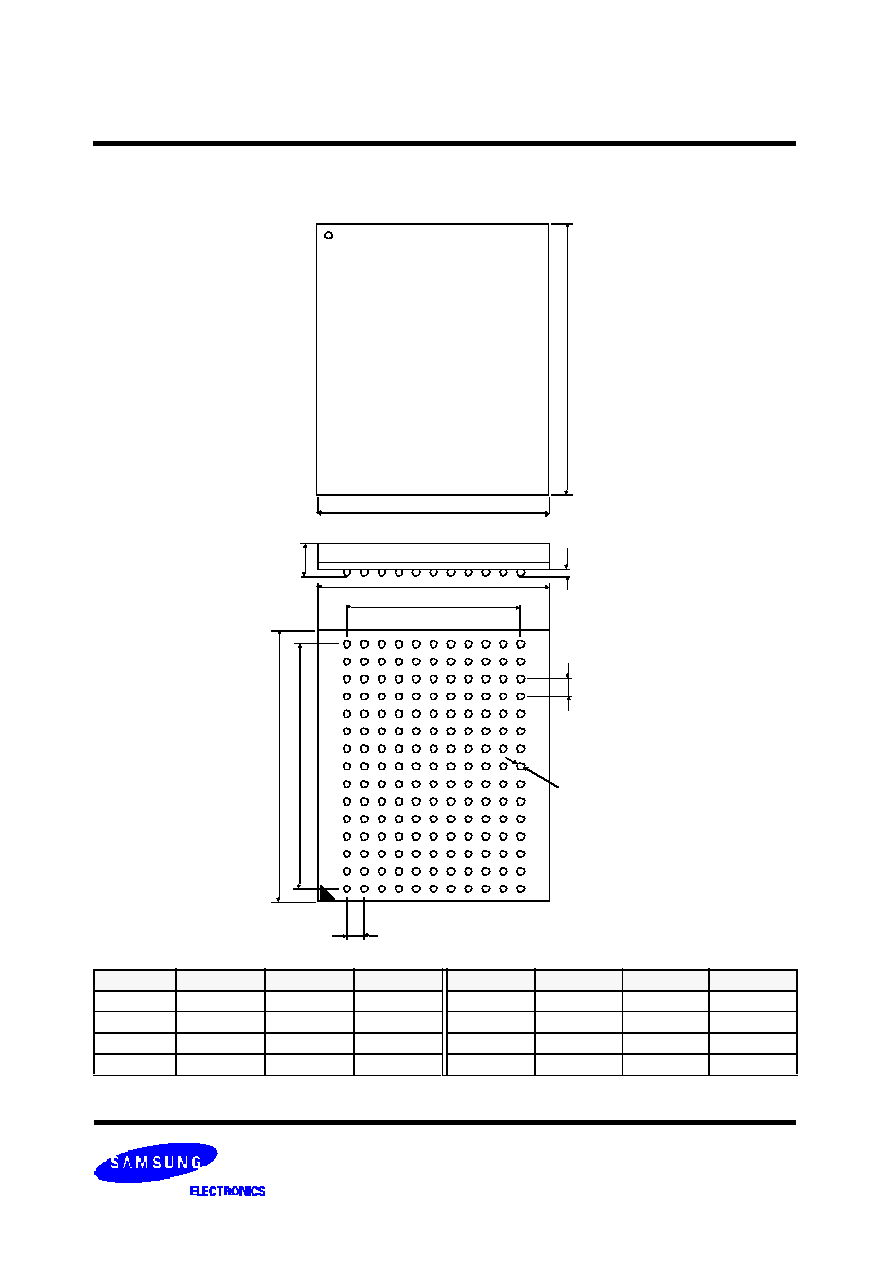
512Kx36 & 1Mx18 & 2Mx8 DDRII CIO b4 SRAM
- 18 -
Rev 0.4
June. 2003
K7I163684B
K7I161884B
K7I160884B
Preliminary
165 FBGA PACKAGE DIMENSIONS
Side View
13mm x 15mm Body, 1.0mm Bump Pitch, 11x15 Ball Array
Bottom View
Top View
Symbol
Value
Units
Note
Symbol
Value
Units
Note
A
13
±
0.1
mm
E
1.0
mm
B
15
±
0.1
mm
F
14.0
mm
C
1.3
±
0.1
mm
G
10.0
mm
D
0.35
±
0.05
mm
H
0.5
±
0.05
mm
C
F
B
H
G
A
B
A
D
E
E

















